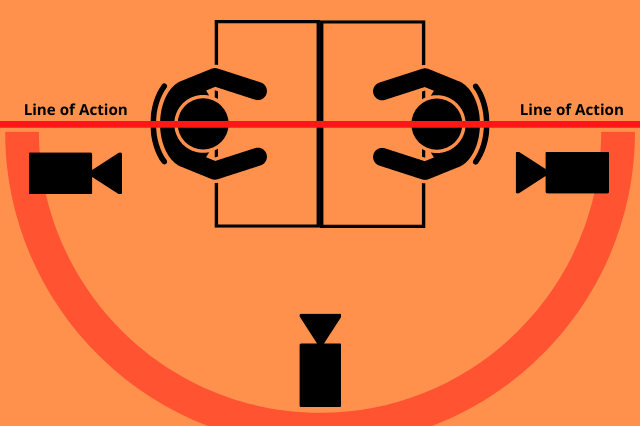Module Overview
This module introduces you to essential elements of film editing and enables you to explore the application of new strategies and competences to work in a professional context. You will learn on professional editing software using industry standard programmes. Through this module you will be introduced to and gain an understanding of the technical challenges associated with the editing process, from ‘synching daily rushes’ to the ‘final cut and sound mix’, working through progressively more difficult non-linear editing systems.
Learning Outcomes
On successful completion of this module you will be expected to be able to:
1. Identify examples of editing for moving image, including developments in technology, key figures and aesthetic considerations.
2. Demonstrate the techniques and processes associated with editing in the realisation of an informed body of work.
3. Demonstrate the ability to work both independently and collaboratively to locate your work in a wider and commercial context.
4. Summarise the decision-making process in the selection of chosen editing techniques.
Assessment Brief
A History of Editing
Aims & Objectives: History of Editing
Identify the pioneers of Moving Image
Understand and explain the development of editing as a part of moving image
Explore historical practitioners in moving image
Discuss advances in technology and editing approaches
https://prezi.com/oafvam6qu_be/editing-techniques/
Key Practitioners in the History of Editing
Edwin S Porter
George Melies
Harold Lloyd
The Lumiere Brothers
The Lumiere Brothers were French inventors and pioneer manufacturers of photographic equipment who devised an early motion-picture camera and projector called the Cinématographe in 1895
Camera Editing- At the time when film making began- Films at this time would consist of one single shot. Directors would film a sequence by filming one scene after the other, in essence no editing.
Stage magician George Melies used in camera edits as a stop motion to make characters disappear on screen.
- 1920’s- Filmmakers were able to make a very believable universe by linking shots together.
- Using Close Ups- getting the audiences attention or creating emotional impact.
- Cross-Cutting to create a more tension for audiences.
Back in the day, audiences would be amazed & blown away by this for George made it look like he made the impossible, possible by using editing techniques in ‘The Vanishing Lady’ in 1896
As editing was developing- film makers were able to edit two scenes together during action sequences allowing the audience to follow the action from two locations.
A Trip to the Moon (French: Le Voyage dans la Lune)[a] is a 1902 French silent film directed by Georges Méliès
Inspired by a wide variety of sources, including Jules Verne’s novels From the Earth to the Moon and Around the Moon, the film follows a group of astronomers who travel to the Moon in a cannon-propelled capsule, explore the Moon’s surface.
Metropolis 1927
Establishing Shots- Are an extreme wide/long shot for the audiences to know where a scene is taking place, location and time. Fritz Lang experimented with special effects, particularly in the scene ‘Maria’s Transformation’ which pioneered visual effects in the Science-Fiction genre.
The Sick Kitten (1901)
During this time in film making, close ups were first developed- moving the camera closer for more an emotional feel.
The Sick Kitten (1903) was one of the first films to feature this camera technique.
Girl Shy (1924)
In the mid 1920’s this film (Girl Shy) by Harold Lloyd- this clip from the film contains Close-ups, POV, Crosscutting, cutaways and multiple camera angles.
The combination of metric, rhythmic and tonal montage. Using objects with a deeper and complicated effect.
During this time in film making, close ups were first developed- moving the camera closer for more an emotional feel.
Film & Editing Techniques
Aims & Objectives: Film & Editing Techiques
- Identify fundamental movements in video production
- Discuss framing & composition techniques
- Explore editing methods and purpose
- Apply an understanding of movement and editing in production
https://prezi.com/embed/nagbys0kc1iq/
The Continuity Editing System
Continuity editing is an editing system used to maintain consistency of both time and space in the film. Continuity editing helps ground audiences in the reality of the film while establishing a clear and structured narrative.
The goal of continuity editing is to make the mechanisms of filmmaking invisible as to help the audience dismiss disbelief more easily.
Continuity editing, also referred to as three-dimensional continuity, is the predominant editing style among commercial Hollywood films.
- Eye line
- Eye trace
- 180 degree rule
- Matching action
The 180 degree rule
In filmmaking, the 180-degree rule is a basic guideline regarding the on-screen spatial relationship between a character and another character or object within a scene.
By keeping the camera on one side of an imaginary axis (the invisible line) between two characters, the first character is always framed right of the second character. (see image below)

Breaking the 180 degree rule
The 180 degree rule is a conventional approach in cinema but it’s a rule that can be broken for great effect and impact.